Chile’s Mapuche-state conflict dates back to the mid-nineteenth century, but there have been repeated shifts in its nature and intensity over time. Understandings of these shifts have tended to be qualitative and irregular, but a new micro-level dataset covering the post-authoritarian period shows how quantitative micro-data can provide powerful new insights into conflict dynamics in Latin America and beyond, write Pedro Cayul (Graduate Institute of International and Development Studies), Alejandro Corvalán (Universidad Diego Portales), Dany Jaimovich (Universidad de Talca), and Matteo Pazzona (Brunel University).
Self-determination struggles are amongst the most persistent conflicts in Latin America, and the case of the Mapuche people and the Chilean state is no exception. Though the conflict dates back to the nineteenth century, it has intensified in recent years, with indigenous groups adopting increasingly violent tactics and the state responding in kind.
But the evidence of such changes tends to be qualitative and patchy, making it difficult to properly track and characterise these shifts. The new Mapuche Conflict Events Database (MACEDA) shows that systematic micro-data can help to overcome this problem by enabling analysis of the fine grain and interdependence of different conflict dynamics.

The Mapuche and indigenous self-determination conflicts in Latin America
Self-determination disputes account for a significant share of conflicts around the world. Roughly a third of the civil wars in recent decades were related to demands for increased autonomy or independence.
Studies in this area have focused on the violent and non-violent strategies adopted by groups within self-determination movements as a means of pursuing their political agenda. Here, Latin America makes a particularly interesting laboratory because the region boasts a large number of indigenous groups that have long been pressing for more autonomy. Though characterised by less violence and a lower media profile than struggles in Mexico and Brazil, the case of the Mapuche in Chile is notable for being one of the oldest and most persistent self-determination conflicts in the Americas.
The Mapuche are indigenous inhabitants of the southern central regions of Chile and Argentina. They share a common social and religious structure, as well as the common Mapudungun language. In Chile, they account for almost 80 per cent of the indigenous population, and about 10 per cent of the total population.
During colonial times, the Mapuche remained mostly independent from the Spanish crown. But when Chile became independent, the situation changed, and between 1860 and 1883 the Chilean army occupied Mapuche territory. The Mapuche were confined to some 3000 small reservations and stripped of most of their lands and assets.
Throughout the twentieth century, the Mapuche have continued to demand the return of their lands, along with political and social recognition. During the Chilean Agrarian Reform of the late 1960s, the government did return thousands of hectares of land to indigenous ownership. However, the military dictatorship of Augusto Pinochet (1973-1989) quickly reversed this process and instead passed laws favouring local landowners and large logging companies.
The return to democracy in the late 1980s created new hope for the Mapuche, but ultimately their longstanding position of relative social and economic deprivation endured. Anger at governmental inaction and continued claims for self-determination have recently seen a turn towards more violent forms of protest, and the Chilean state has responded with aggressive tactics of its own. But both the fine grain and the broad trends in these changes have tended to be obscured by partial and sometimes sensationalist media accounts.

Harnessing Mapuche data
Academic work on the recent intensification of the Mapuche-state conflict in Chile has been predominantly qualitative, but even this is scarce and scattered. It was this lack of consistent data that led us to create the Mapuche Conflict Event Dataset (MACEDA), which covers the period between 1990 and 2016. MACEDA describes and classifies more than 3000 events and represents one of the first systematic micro-data projects covering a self-determination conflict, as well as being the first for a specifically indigenous self-determination conflict.
A “conflict event” is one in which actors and/or motivation are related to the Mapuche conflict, be it a violent land invasion, a peaceful demonstration, or a police raid. Like other well-known conflict databases such as the Armed Conflict Location and Events Dataset and the Uppsala Conflict Data Program, MACEDA’s data is derived from media sources.
The most important media source in MACEDA is Chile’s newspaper of record El Mercurio. But given that this publication’s noticeable editorial bias could lead to under-reporting of some types of events, such as state coercion episodes, we utilise other media to attenuate partiality.
Relevant reports from these sources were identified using actor-based keywords such as Mapuche or CAM. For each event, MACEDA reports 38 variables, including the names of the actors involved, a brief description, and the number of people involved. Events were manually coded by a group of researchers.
MACEDA is part of the wider Mapuche Data Project (MDP), which aims to systematise and make available various databases on Mapuche demography, politics, and land. By quantitatively describing these key socioeconomic dimensions of the Mapuche struggle, MDP enables us to interrogate issues like the relationship between protest and police repression, ethnic fragmentation and levels of conflict, or land policy and conflict dynamics.
The Mapuche-state conflict in recent years
As is clear from the figure below, in the early years of the post-authoritarian period (1990-1996) there were hopes of a change for the better amongst indigenous people. In 1993, the Chilean congress passed the Indigenous Law, which established the National Corporation for Indigenous Development (CONADI). One of the main aims of this institution was to buy ancestral lands from private owners and transfer them to indigenous communities. In these years, the level of conflict was very low, and most of the events were non-violent, either protests or symbolic land occupations.
However, things soon took a turn for the worse. The new institutional framework was flawed and lacked an efficient means of resolving controversies. And in parallel the government was promoting expansion of the extractive logging industry, which ran counter to indigenous interests and land claims. At this point, the Mapuche began to organise in larger groups and shifted towards increasingly violent tactics, leading to an escalation of the conflict in general.
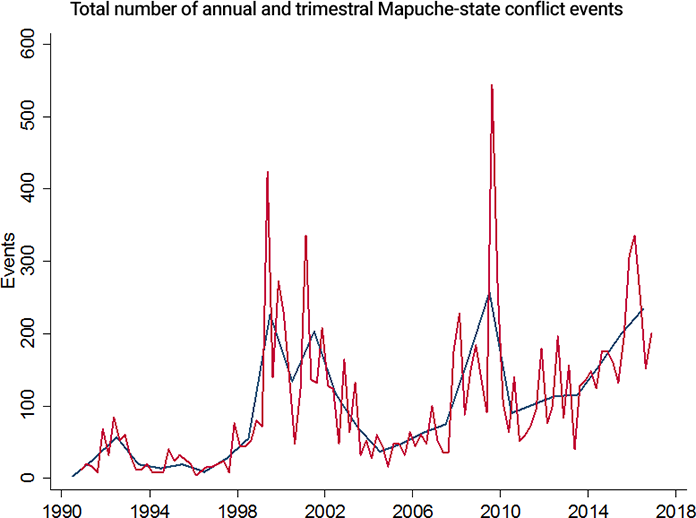
A new period of arson, truck burnings, and violent occupations began in the late 1990s, as is clear when we disaggregate conflict data by category (as in the graph below). Over the following years, organisations such as the Coordinadora Arauco-Malleco (CAM), a Mapuche movement focused on recovery of Mapuche land, used direct action and sabotage to reclaim ancestral lands and gain political autonomy.
The conflict reduced in intensity after 2003, mainly due to the repressive tactics employed by the police and other state agencies. However, towards the end of the 2000s a new escalation began, and one that has persisted into the present day.
The key difference with the current spike is its sheer level of violence. As the figure below demonstrates, most of the recent rise in conflict events is accounted for by “attacks and threats”, as opposed to the largely peaceful “land invasions” and “protests” seen during other periods. The nature of these attacks and threats has also changed, with new types of violent actions such as church and school burnings, damage to public infrastructure, and attacks on private corporations.
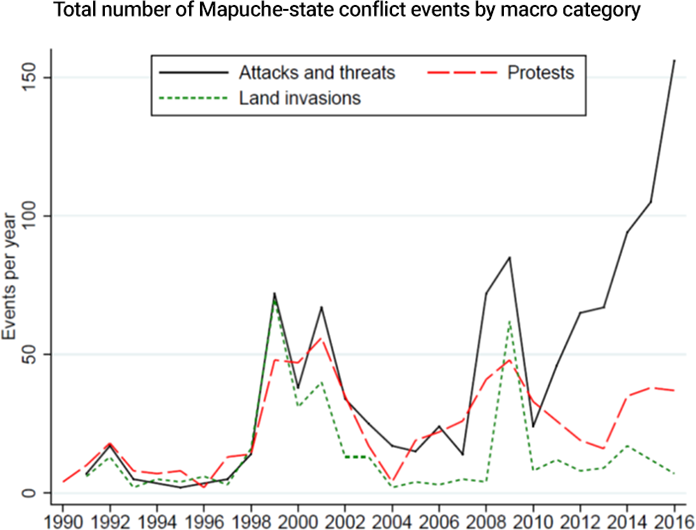
Understanding the latest spike in Mapuche-state violence
The reasons for the recent escalation are many.
One hypothesis, testable with MACEDA, is that the fragmentation of the CAM organisation led to the emergence of new violent groups. This is analogous to aspects of recent violence in Mexico, where state coercion undermined the internal stability of the major cartels and created an opportunity that less-established groups attempted to exploit through violence.
In Chile, a clear example of rising violence is the recent killing by police special forces of Mapuche youth leader Camilo Catrillanca. The revelation that Catrillanca was not himself involved in any violent action or crime exacerbated an already difficult situation, raising tensions ever higher between the Mapuche and state actors.
MACEDA shows that cases like that of Carmilo Catrillanca are relatively rare, with a total of 22 deaths between 1990 and 2016, which is less than one per year. That said, aside from the important social and economic consequences of the conflict, 22 deaths is clearly 22 too many.
At this point, with the intensity of conflict high and getting higher, it is vital to take stock of the current situation and to begin to chart course towards a peaceful resolution. Here as in self-determination conflicts the world over, reliable and consistent statistics on conflict dynamics can play a part in moving towards this vital goal.
Notes:
• The views expressed here are of the authors and do not reflect the position of the Centre or of the LSE
• Please read our Comments Policy before commenting



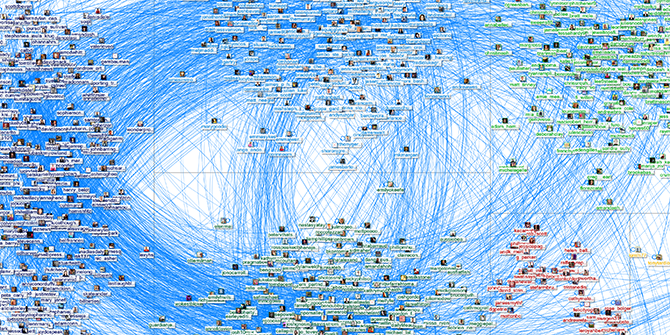
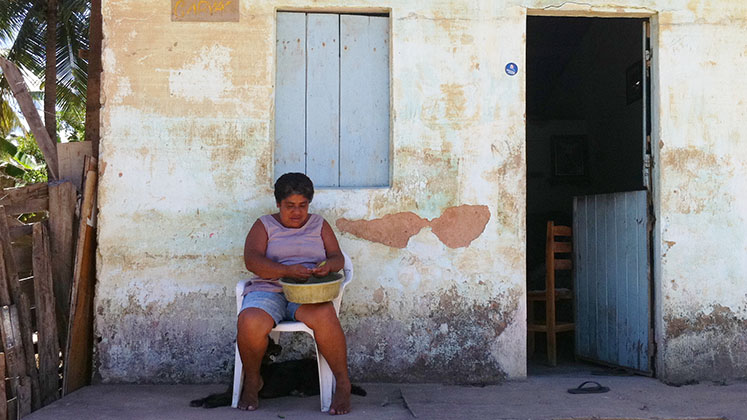
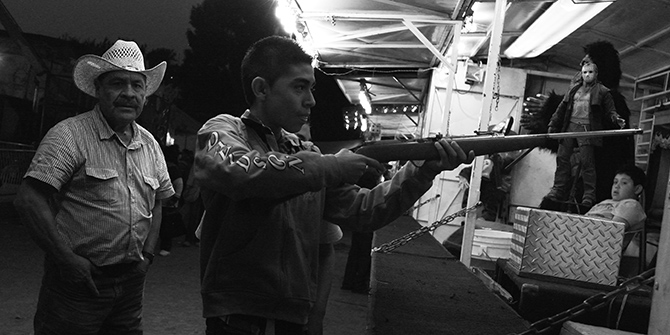
How come capitalism vanishes from the analysis or isn’t a strucutrual component of the larger historical context described ?
Thanks. Although capitalism is relevant, the creation of private property in the area dates only to the late 19th century. We have an updated version of the paper where you can find more detail https://www.researchgate.net/publication/343948477_Introducing_MACEDA_New_micro-data_on_an_indigenous_self-determination_conflict